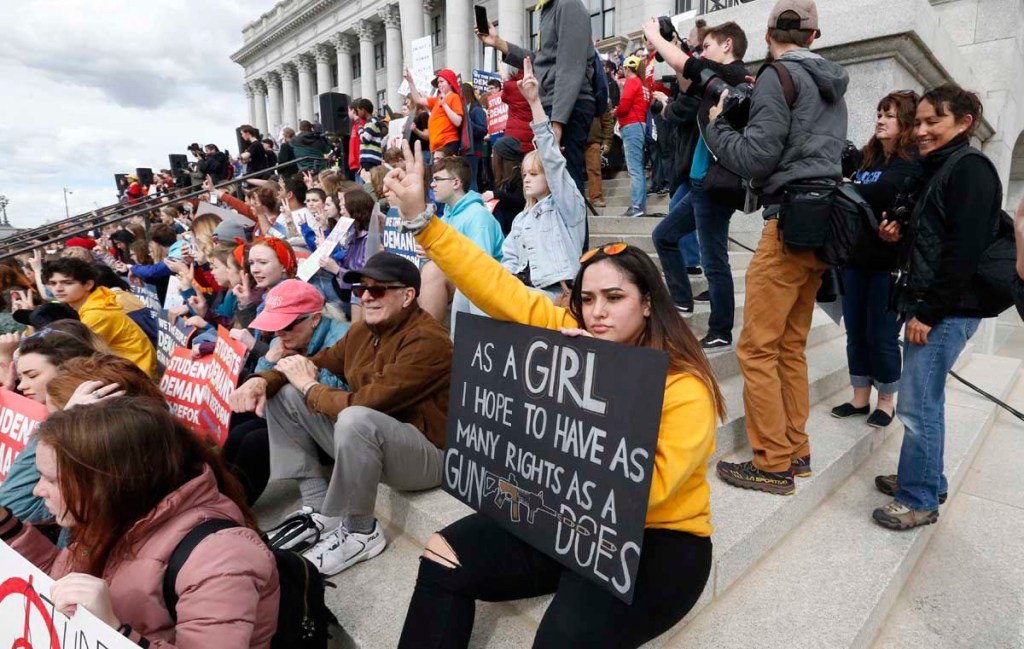‘Fight for your lives’: Marchers deliver call for school safety, tougher gun laws
Published 8:22 pm Saturday, March 24, 2018

- Thousands of protesters flood the Utah State Capitol on Saturday, March 24, 2018, in Salt Lake City, seeking stronger gun-control measures in response to last month's school shooting in Parkland, Fla. (AP Photo/Rick Bowmer)
WASHINGTON, D.C. – The emotional sequencing of fear to grief, anger to resolve gave rise to Saturday’s March For Our Lives, millions drawn to action nationwide in a unified call for gun control measures to better protect schools and other soft targets.
The nation’s capital served as the March’s hub, the primary site and de facto big sibling to numerous demonstrations spanning time zones and borders. National media estimates put the D.C. crowd at 800,000, stretching 13 blocks along Pennsylvania Avenue from near the foot of the Capitol west to the White House.
Trending
At the center of it all were school kids – angered and motivated to bring about change amid an underlying sense they could one day be targets in the crosshairs of a random gunman. That’s how Saturday’s demonstrations came about – inspired and organized by survivors of the Marjory Stoneman Douglas High School shooting in Florida that claimed the lives of 14 students and three staffers.
Stoneman Douglas survivors pushed themselves to become gun control advocates in the immediate aftermath of the Feb. 14 Parkland, Fla., massacre – one of America’s deadliest mass shootings. They mobilized support through traditional media, and more so through social media, using hashtags such as #NeverAgain and #MarchForOurLives, drawing support that reached its latest crescendo Saturday – but perhaps not its last.
Marjory Stoneman Douglas senior Emma Gonzalez, who quickly became a leader in this student-led movement, closed the event. She stood defiantly on stage and told of the “would-nevers” lost in the deaths of the school’s 17 victims.
Carmen Schentrup would never complain to Gonzalez about piano practice. Aaron Feis, a football coach who died protecting others, would never call his student “sunshine.” Alex Schachter would never walk into school with his brother, Ryan. Scott Beigel would never joke around with Cameron Kasky at camp.
Again and again, the victim’s names followed would-nevers. She choked up as she then stood silent, the enormous crowd following suit – the day’s only truly silent moment.
Gonzalez stayed on stage 6 minutes, 20 seconds, the time it took a gunman to shoot up her school and forever alter the lives of people in Parkland and beyond.
Trending
“Fight for your lives,” Gonzalez implored before exiting the stage, “before it is someone else’s job.”
Gonzalez was one of 20 speakers interspersed with performances from pop stars Miley Cyrus, Ariana Grande, Jennifer Hudson and more. The music kept high the spirits of the crowd – but it was the emotionally charged commentary of teens and children that energized the crowd the most.
There was a mix of Stoneman Douglas students and high-schoolers and middle-schoolers from cities such as Chicago and Los Angeles, plus survivors from the 2012 Sandy Hook shooting in Connecticut.
Each speaker drew on his or her emotions, and they spoke of tragedies in their own lives – siblings and friends shot dead in and out of school – and called for a change in America’s gun culture.
Jaclyn Corin of Stoneman Douglas urged the hundreds of thousands in the crowd to contact their legislators, reminding that Congress is in recess and those representatives may be available at local district offices.
Her classmate, Alex Wind, pushed attendees to hold their legislators accountable in stating publicly where they stand on gun control. Trevon Bosley, of Chicago, criticized his city for investing in tourism rather than vocational training and job readiness toward giving direction to young people who sorely need guidance.
Student Cameron Kasky, of Stoneman Douglas, called for a ban on the sale of assault weapons and high-capacity magazines and the implementation of universal background checks.
“Politicians, either represent the people or get out,” Kasky said to raucous cheering at the March’s outset. “Beware, the voters are coming.”
Future voters also participated – including 11-year-old Naomi Wadler, of Virginia, who led a walkout at her middle school. She told the crowd it was just seven years until she and her peers would have the right to vote.
Wadler said she took the stage to tell the stories of a group she believes is too often forgotten, black women and girls.
Edna Chavez of Los Angeles honored her late brother slain by a bullet. Zion Kelly, of Washington, D.C., did the same for his twin brother.
From the crowd came frequent chants rolling from back to front, side to side, echoing through the National Mall: “Vote them out!”




